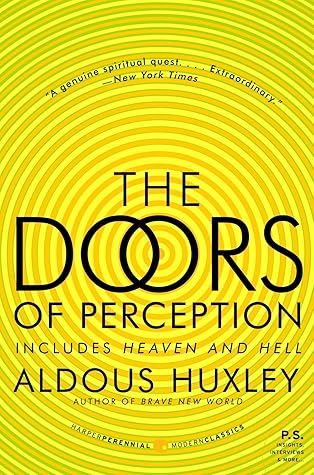More on this book
Community
Kindle Notes & Highlights
We live together, we act on, and react to, one another; but always and in all circumstances we are by ourselves.
Space was still there; but it had lost its predominance. The mind was primarily concerned, not with measures and locations, but with being and meaning.
The function of the brain and nervous system is to protect us from being overwhelmed and confused by this mass of largely useless and irrelevant knowledge, by shutting out most of what we should otherwise perceive or remember at any moment, and leaving only that very small and special selection which is likely to be practically useful.”
That which, in the language of religion, is called “this world” is the universe of reduced awareness, expressed, and, as it were, petrified by language.
When the brain runs out of sugar, the undernourished ego grows weak, can’t be bothered to undertake the necessary chores, and loses all interest in those spatial and temporal relationships which mean so much to an organism bent on getting on in the world.
In the final stage of egolessness there is an “obscure knowledge” that All is in all—that All is actually each. This is as near, I take it, as a finite mind can ever come to “perceiving everything that is happening everywhere in the universe.”
(To a person whose transfigured and transfiguring mind can see the All in every this, the first-rateness or tenth-rateness of even a religious painting will be a matter of the most sovereign indifference.)
Art, I suppose, is only for beginners, or else for those resolute dead-enders, who have made up their minds to be content with the ersatz of Suchness, with symbols rather than with what they signify, with the elegantly composed recipe in lieu of actual dinner.
“This is how one ought to see,” I kept saying as I looked down at my trousers, or glanced at the jeweled books in the shelves, at the legs of my infinitely more than Van-Goghian chair. “This is how one ought to see, how things really are.” And yet there were reservations. For if one always saw like this, one would never want to do anything else. Just looking, just being the divine Not-self of flower, of book, of chair, of flannel. That would be enough. But in that case what about other people? What about human relations? In the recording of that morning’s conversations I find the question
...more
This highlight has been truncated due to consecutive passage length restrictions.
And anyhow the body seemed perfectly well able to look after itself. In reality, of course, it always does look after itself. All that the conscious ego can do is to formulate wishes, which are then carried out by forces which it controls very little and understands not at all.
For the moment that interfering neurotic who, in waking hours, tries to run the show, was blessedly out of the way.
Let there be a voice to assure them, by day and even while they are asleep, that in spite of all the terror, all the bewilderment and confusion, the ultimate Reality remains unshakably itself and is of the same substance as the inner light of even the most cruelly tormented mind.
Gestalt psychologists, such as Samuel Renshaw, have devised methods for widening the range and increasing the acuity of human perceptions. But do our educators apply them? The answer is, No.
To be enlightened is to be aware, always, of total reality in its immanent otherness—to be aware of it and yet to remain in a condition to survive as an animal, to think and feel as a human being, to resort whenever expedient to systematic reasoning.
Our goal is to discover that we have always been where we ought to be.
We are forever attempting to convert things into signs for the more intelligible abstractions of our own invention. But in doing so, we rob these things of a great deal of their native thinghood.
The meditating philosopher sits there in his island of inner illumination; and at the opposite end of the symbolic chamber, in another, rosier island, an old woman crouches before the hearth. The firelight touches and transfigures her face, and we see, concretely illustrated, the impossible paradox and supreme truth—that perception is (or at least can be, ought to be) the same as Revelation, that Reality shines out of every appearance, that the One is totally, infinitely present in all particulars.


